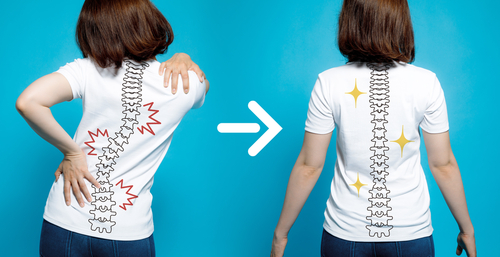
If you or a loved one is enduring scoliosis, you’d want to learn all about the scoliosis treatment options you have. In today’s post, we’ll look at chiropractic care as a viable scoliosis treatment option.
We’ll cover some of the basics of chiropractic treatment and how it can alleviate pain, improve physical function, and enhance posture.
What Is Scoliosis?
First, let’s talk about this condition. Our spine is naturally engineered to have three curves. It’s supposed to create an “S” shape if you’re looking at it from the side.
Someone with scoliosis has an irregular curvature of the spine. Their spine will show a side-to-side curve, up to 10 degrees. The spine will show either a “C” or “S” shape from the rear or front view of the body, rather than from the side like normal.

This lateral or sideways curvature of the spine is not always physically visible to us. Those with scoliosis will show signs of uneven waist, shoulders, or hips. In some cases, they will also show a significant hump on the rib or a bulge on the lower back next to the spine’s curvature.
Types of Scoliosis
Idiopathic Curve
The idiopathic curve is the most common type of this condition. Unfortunately, there is no definite cause of this type of scoliosis.
Congenital Curve
This condition means the spinal abnormality started at birth. Congenital scoliosis is quite a rare occurrence. It is typically diagnosed early in childhood years.
Myopathic Deformity
Myopathic is when the muscles of the body don’t work as they should. This condition can lead to uncommon spinal curves. Some of the causes of myopathic deformity are polio, cerebral palsy, or muscular dystrophy.
Paralytic Curve
Similar to myopathic, paralytic scoliosis is a result of the muscles – in this case, around the spine – not working correctly. Often, the result of the dysfunctionality of the muscles is spinal cord injuries, causing scoliosis.
Other Conditions
Some other conditions in the spine that contribute to irregular curvature are osteoporosis, degenerative disc disease, and osteomalacia. These conditions can add to the effects of scoliosis and are classified as “secondary scoliosis.”
In some other cases, spinal surgical procedures can lead to an imbalance in our spine, which can then lead to the diagnosis of scoliosis.
Chiropractic: Your Scoliosis Treatment
Those living with this condition may be surprised to discover that chiropractic is a viable scoliosis treatment method.
Chiropractic adjustment techniques are utilized as spinal support. The methods are effective in reducing pain and thwarting additional spinal degradation. Getting this scoliosis treatment will ultimately help improve your quality of life.
Degenerative Adult Scoliosis

This is the type of scoliosis most adults experience. They will typically suffer from lower back pain, which often leads to this diagnosis. There may not be other signs during their younger years; it only manifests once they are older.
Over time, the increased tension on the nerves leads to numbness, pain, and severe pain in the lower parts of the body. More severe cases lead to complete loss of mobility and coordination.
How Can Chiropractors Help in Scoliosis Treatment?
Those with scoliosis have to deal with everyday discomfort and pain – both physically and emotionally. Many people diagnosed with this condition are often required to wear bulky and visible braces for support – that may be a cause for insecurities and embarrassment.
When it comes to scoliosis treatment and fixing the condition, we first have to understand what “fixing it” entails. It’s widely known that chiropractic can help enhance the quality of life of scoliosis patients. However, this case requires a more in-depth understanding.
Treatable vs. Curable
Scoliosis is treatable. However, the condition is not curable. What’s the difference? If you are familiar with diabetes, scoliosis is similar to that. You can manage the condition, but you have to undergo ongoing care.
When you stay dedicated to the scoliosis treatment plan that your chiropractor created and recommended for you, you’re on your way to having an improved quality of life. And you wouldn’t even have to worry about undergoing surgery or having to wear a brace.
However, be wary of chiropractors – or other healthcare professionals for that matter – who promise quick solutions. As we mentioned above, to effectively manage scoliosis, ongoing care is required. The condition won’t magically go away overnight. We strongly advise getting consistent care from a chiropractor experienced in treating scoliosis.